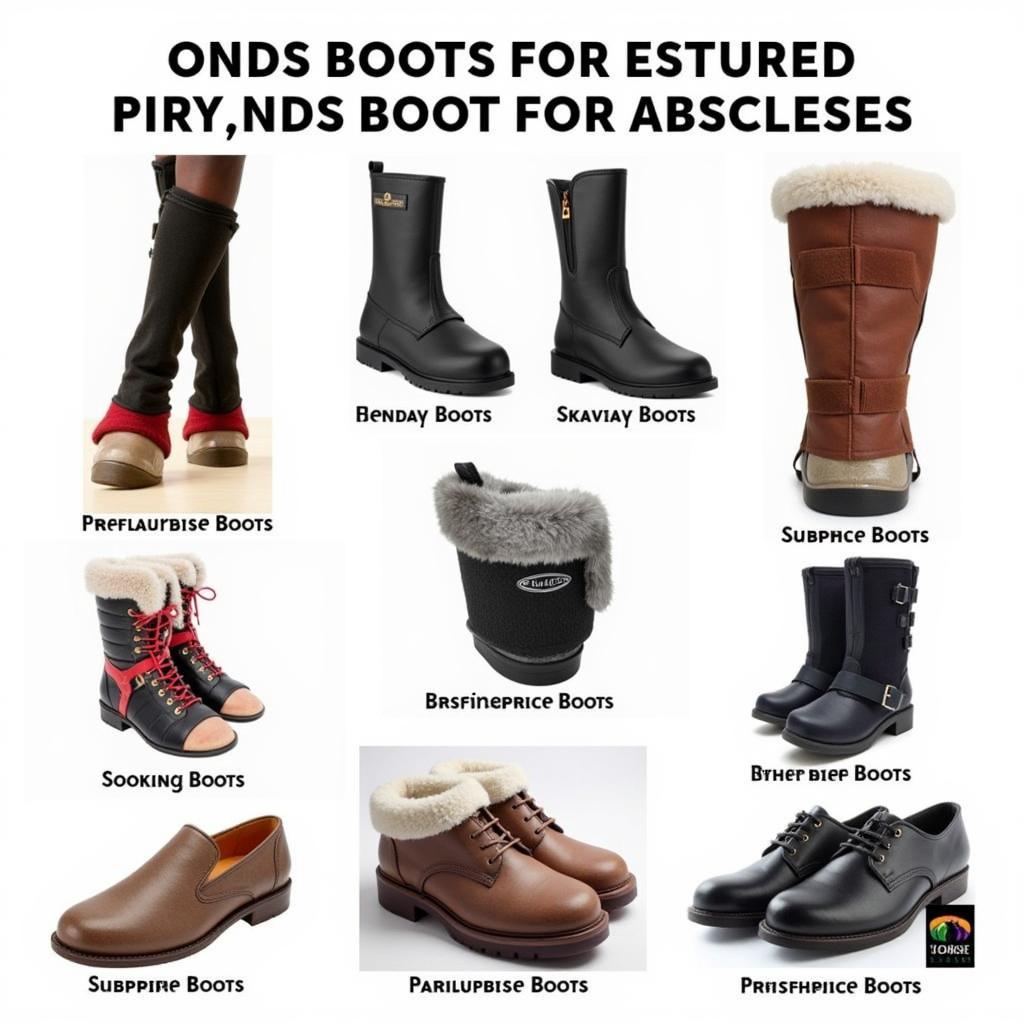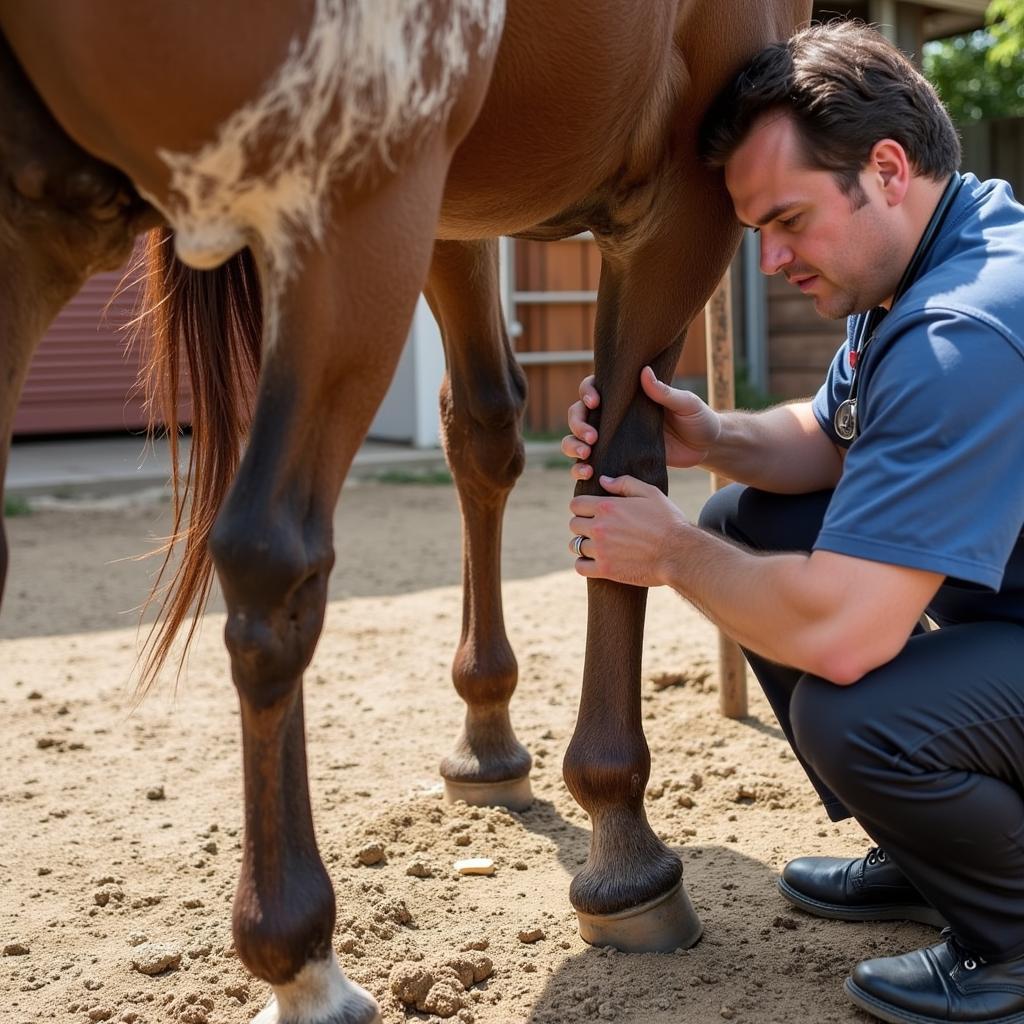An abscess in your horse’s hoof can be a painful experience for your equine companion, and finding the right Horse Boot For Abscess is crucial for their recovery. This comprehensive guide will delve into the importance of using horse boots for abscesses, the different types available, and how to choose the best option for your horse’s needs.
 Horse Hoof Abscess Boot
Horse Hoof Abscess Boot
Understanding Horse Hoof Abscesses
A hoof abscess is a painful condition caused by a bacterial infection that forms within the hoof capsule. The infection leads to a build-up of pus and pressure, causing significant discomfort to the horse. Common causes of abscesses include puncture wounds, cracks in the hoof wall, or thrush infections.
Why Use a Horse Boot for Abscess?
Using a horse boot for an abscess is essential for several reasons:
- Protection: The boot provides a protective barrier for the affected hoof, preventing further contamination and injury.
- Support: It helps stabilize the hoof, reducing strain and pressure on the abscess area, which promotes healing.
- Drainage: Some boots are designed to facilitate drainage of the abscess, allowing pus to escape and preventing further complications.
- Medication Application: The boot can hold poultice or other medications in place against the hoof, maximizing their effectiveness.
Types of Horse Boots for Abscess
There are several types of horse boots available, each with its advantages:
1. Protective Boots
These boots are typically made of durable materials like rubber or polyurethane. They offer excellent protection from external elements and debris, making them suitable for horses recovering from drained abscesses.
 Different Types of Horse Boots for Abscess
Different Types of Horse Boots for Abscess
2. Soaking Boots
Soaking boots are designed to hold liquids, making them ideal for Epsom salt soaks, which can draw out infection and reduce inflammation. They are usually made of soft, flexible materials and have a secure closure system to prevent leaks.
3. Therapy Boots
Therapy boots often incorporate features like compression, magnetic therapy, or infrared heat. While not specifically designed for abscesses, they can aid in pain relief, reduce inflammation, and promote circulation to support healing.
4. Custom-Made Boots
In some cases, especially for horses with unique hoof shapes or severe abscesses, custom-made boots might be necessary. These boots are crafted by professionals to provide a precise fit and optimal support.
Choosing the Best Horse Boot for Abscess: Factors to Consider
Choosing the right horse boot for an abscess requires careful consideration of several factors:
- Severity of the Abscess: For a recently drained abscess, a soaking boot might be most beneficial, while a protective boot is suitable for the later stages of healing.
- Horse’s Comfort: Ensure the boot fits well and doesn’t cause any discomfort or rubbing. Look for breathable materials and adjustable straps.
- Durability: Choose a boot made from durable, long-lasting materials, especially if your horse will be wearing it for extended periods.
- Ease of Use: Select a boot that is easy to put on and take off, even with a potentially sensitive horse.
- Veterinarian’s Recommendation: Always consult your veterinarian for guidance on the best type of boot and treatment plan for your horse’s specific needs.
When to Consult a Veterinarian
It’s crucial to consult your veterinarian if you suspect your horse has an abscess. Early diagnosis and treatment are vital for successful recovery. Additionally, seek veterinary advice if:
- The abscess doesn’t improve with home treatment.
- The horse shows signs of severe pain or lameness.
- You notice any unusual discharge or swelling.
 Veterinarian Treating Horse Hoof
Veterinarian Treating Horse Hoof
Tips for Using a Horse Boot for Abscess
- Keep the Boot Clean and Dry: Regularly clean the boot and allow it to dry completely to prevent bacterial growth and moisture build-up.
- Check the Fit Regularly: Ensure the boot remains snug but not too tight to avoid discomfort or restriction of blood flow.
- Monitor the Healing Process: Regularly check the abscess for signs of improvement or complications.
Conclusion
Selecting the right horse boot for abscess plays a vital role in your horse’s recovery and comfort. By understanding the different types of boots available and considering your horse’s specific needs, you can make an informed decision that supports their healing and well-being. Remember, always consult your veterinarian for personalized guidance and treatment recommendations.
Looking for the right equipment to support your horse’s hoof health? Check out our selection of bar shoes for horses and equine fusion horse boots to find the best options for your equine partner.
FAQs About Horse Boots for Abscess
1. How long should a horse wear a boot for an abscess?
The duration varies depending on the severity and healing progress. Your veterinarian will advise on the appropriate wearing time.
2. Can I use a regular horse boot for an abscess?
While regular boots offer some protection, it’s best to use boots specifically designed for abscesses as they provide features that aid in healing.
3. How do I clean a horse boot used for an abscess?
Use a mild disinfectant solution and thoroughly rinse and dry the boot after each use.
4. What are the signs that a horse abscess is healing?
Signs of healing include reduced lameness, decreased swelling, and absence of pus discharge.
5. Can I prevent horse abscesses?
While not entirely preventable, you can minimize the risk by maintaining good hoof hygiene, providing a clean environment, and scheduling regular farrier appointments.
For further information on hoof care and related topics, explore our article on horse hoof bleeding after trim.
Need further assistance with your horse’s hoof health or finding the perfect boot? Don’t hesitate to reach out to us. Contact us at: Phone Number: 0772127271, Email: [email protected] Or visit us at: QGM2+WX2, Vị Trung, Vị Thuỷ, Hậu Giang, Việt Nam. Our dedicated customer support team is available 24/7 to assist you.